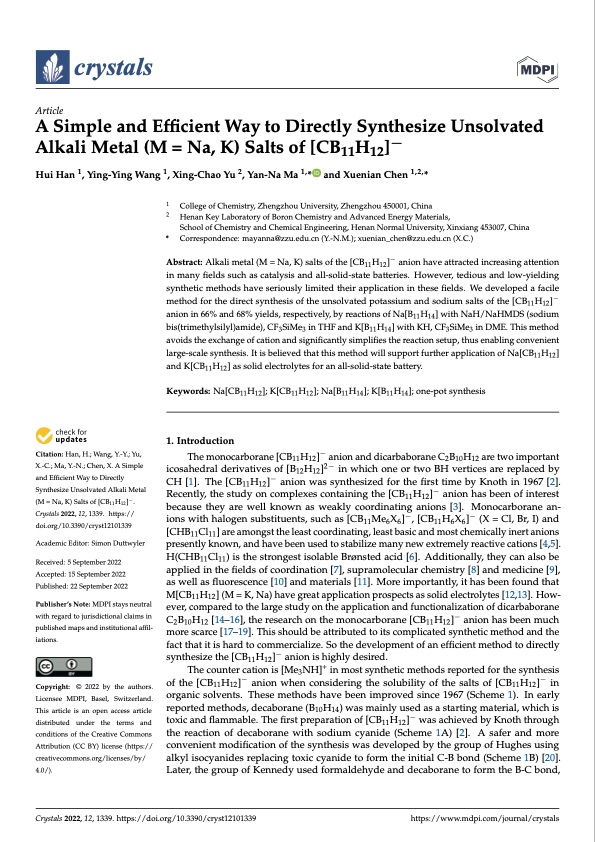
PDF Publication Title:
Text from PDF Page: 001
crystals Article A Simple and Efficient Way to Directly Synthesize Unsolvated Alkali Metal (M = Na, K) Salts of [CB11H12]− Hui Han 1, Ying-Ying Wang 1, Xing-Chao Yu 2, Yan-Na Ma 1,* and Xuenian Chen 1,2,* 1 2 * Correspondence: mayanna@zzu.edu.cn (Y.-N.M.); xuenian_chen@zzu.edu.cn (X.C.) Abstract: Alkali metal (M = Na, K) salts of the [CB11H12]− anion have attracted increasing attention in many fields such as catalysis and all-solid-state batteries. However, tedious and low-yielding synthetic methods have seriously limited their application in these fields. We developed a facile method for the direct synthesis of the unsolvated potassium and sodium salts of the [CB11H12]− anion in 66% and 68% yields, respectively, by reactions of Na[B11H14] with NaH/NaHMDS (sodium bis(trimethylsilyl)amide), CF3SiMe3 in THF and K[B11H14] with KH, CF3SiMe3 in DME. This method avoids the exchange of cation and significantly simplifies the reaction setup, thus enabling convenient large-scale synthesis. It is believed that this method will support further application of Na[CB11H12] and K[CB11H12] as solid electrolytes for an all-solid-state battery. Keywords: Na[CB11H12]; K[CB11H12]; Na[B11H14]; K[B11H14]; one-pot synthesis 1. Introduction The monocarborane [CB11H12]− anion and dicarbaborane C2B10H12 are two important icosahedral derivatives of [B12 H12 ]2 − in which one or two BH vertices are replaced by CH [1]. The [CB11H12]− anion was synthesized for the first time by Knoth in 1967 [2]. Recently, the study on complexes containing the [CB11H12]− anion has been of interest because they are well known as weakly coordinating anions [3]. Monocarborane an- ions with halogen substituents, such as [CB11Me6X6]−, [CB11H6X6]− (X = Cl, Br, I) and [CHB11Cl11] are amongst the least coordinating, least basic and most chemically inert anions presently known, and have been used to stabilize many new extremely reactive cations [4,5]. H(CHB11Cl11) is the strongest isolable Brønsted acid [6]. Additionally, they can also be applied in the fields of coordination [7], supramolecular chemistry [8] and medicine [9], as well as fluorescence [10] and materials [11]. More importantly, it has been found that M[CB11H12] (M = K, Na) have great application prospects as solid electrolytes [12,13]. How- ever, compared to the large study on the application and functionalization of dicarbaborane C2B10H12 [14–16], the research on the monocarborane [CB11H12]− anion has been much more scarce [17–19]. This should be attributed to its complicated synthetic method and the fact that it is hard to commercialize. So the development of an efficient method to directly synthesize the [CB11H12]− anion is highly desired. The counter cation is [Me3NH]+ in most synthetic methods reported for the synthesis of the [CB11H12]− anion when considering the solubility of the salts of [CB11H12]− in organic solvents. These methods have been improved since 1967 (Scheme 1). In early reported methods, decaborane (B10H14) was mainly used as a starting material, which is toxic and flammable. The first preparation of [CB11H12]− was achieved by Knoth through the reaction of decaborane with sodium cyanide (Scheme 1A) [2]. A safer and more convenient modification of the synthesis was developed by the group of Hughes using alkyl isocyanides replacing toxic cyanide to form the initial C-B bond (Scheme 1B) [20]. Later, the group of Kennedy used formaldehyde and decaborane to form the B-C bond, College of Chemistry, Zhengzhou University, Zhengzhou 450001, China Henan Key Laboratory of Boron Chemistry and Advanced Energy Materials, School of Chemistry and Chemical Engineering, Henan Normal University, Xinxiang 453007, China Citation: Han, H.; Wang, Y.-Y.; Yu, X.-C.; Ma, Y.-N.; Chen, X. A Simple and Efficient Way to Directly Synthesize Unsolvated Alkali Metal (M = Na, K) Salts of [CB11H12]−. Crystals2022,12,1339. https:// doi.org/10.3390/cryst12101339 Academic Editor: Simon Duttwyler Received: 5 September 2022 Accepted: 15 September 2022 Published: 22 September 2022 Publisher’s Note: MDPI stays neutral with regard to jurisdictional claims in published maps and institutional affil- iations. Copyright: © 2022 by the authors. Licensee MDPI, Basel, Switzerland. This article is an open access article distributed under the terms and conditions of the Creative Commons Attribution (CC BY) license (https:// creativecommons.org/licenses/by/ 4.0/). Crystals 2022, 12, 1339. https://doi.org/10.3390/cryst12101339 https://www.mdpi.com/journal/crystalsPDF Image | Efficient Way to Directly Synthesize Unsolvated Alkali Metal

PDF Search Title:
Efficient Way to Directly Synthesize Unsolvated Alkali MetalOriginal File Name Searched:
crystals-12-01339.pdfDIY PDF Search: Google It | Yahoo | Bing
Product and Development Focus for Salgenx
Redox Flow Battery Technology: With the advent of the new USA tax credits for producing and selling batteries ($35/kW) we are focussing on a simple flow battery using shipping containers as the modular electrolyte storage units with tax credits up to $140,000 per system. Our main focus is on the salt battery. This battery can be used for both thermal and electrical storage applications. We call it the Cogeneration Battery or Cogen Battery. One project is converting salt (brine) based water conditioners to simultaneously produce power. In addition, there are many opportunities to extract Lithium from brine (salt lakes, groundwater, and producer water).Salt water or brine are huge sources for lithium. Most of the worlds lithium is acquired from a brine source. It's even in seawater in a low concentration. Brine is also a byproduct of huge powerplants, which can now use that as an electrolyte and a huge flow battery (which allows storage at the source).We welcome any business and equipment inquiries, as well as licensing our flow battery manufacturing.| CONTACT TEL: 608-238-6001 Email: greg@salgenx.com | RSS | AMP |